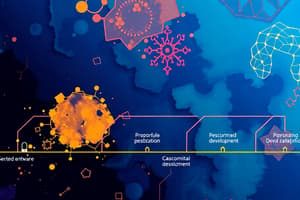Podcast
Questions and Answers
What should drive the design for future business processes?
What should drive the design for future business processes?
- Regulatory requirements
- Customer feedback
- Existing business processes
- Future business plans (correct)
Which of the following is NOT one of Drucker's questions for clarifying a mission statement?
Which of the following is NOT one of Drucker's questions for clarifying a mission statement?
- Who are our competitors? (correct)
- Where is the customer located?
- What products does the customer want?
- What is our business?
What is the purpose of rapid delivery methods in enterprise architecture?
What is the purpose of rapid delivery methods in enterprise architecture?
- To delay business transformation.
- To maintain legacy processes
- To implement existing processes more responsively (correct)
- To reduce management involvement
How many steps are there in the strategy analysis process?
How many steps are there in the strategy analysis process?
What is the first step in the strategy analysis process?
What is the first step in the strategy analysis process?
Which aspect focuses on 'what' an organization exists for according to Drucker?
Which aspect focuses on 'what' an organization exists for according to Drucker?
What key factor should be determined when identifying issues in strategy analysis?
What key factor should be determined when identifying issues in strategy analysis?
What might influence the design of business processes despite their outdated nature?
What might influence the design of business processes despite their outdated nature?
What is the final step in the strategy analysis process?
What is the final step in the strategy analysis process?
What is the key strategic thrust supposed to address according to Drucker's questions?
What is the key strategic thrust supposed to address according to Drucker's questions?
Flashcards are hidden until you start studying
Study Notes
Structure of Modular Programs and Evolution of Software Engineering
- Structure charts (SCs) were created to organize modular programs effectively.
- Manual enterprise processes varied by how orders were received (e.g., mail, phone).
- Automated processes revealed multiple versions of order entry, leading to maintenance challenges.
- Program maintenance chaos resulted from redundant data stores and disorganized data maintenance.
- Redundant staffing and training lead to increased costs and decreased profitability.
Development of Relational Database Technology
- Late 1960s to 1970s saw the emergence of relational database technology, foundational for current systems.
- IBM DB2 and Oracle RDBMS were among the first relational database management systems (RDBMS).
- Mid-1970s focused on data modeling methods aimed at eliminating redundant data using normalization.
Object-Oriented Methods and Enterprise Architecture Planning
- The 1980s introduced object-oriented (O-O) development and Unified Modeling Language (UML), enhancing code reusability.
- Enterprise Architecture Planning (EAP) focuses on analyzing data, applications, and technology across an enterprise.
- FEAF (Federal Enterprise Architecture Framework) utilizes Dr. Steven Spewak's EAP to define architecture planning.
Enterprise Architecture Plan (EAP) Layers
- Layer 1: Establish a work plan emphasizing management commitment and methodology selection.
- Layer 2: Analyze the current architecture and systems technology to create a migration plan.
- Layer 3: Define a vision with data, applications, and technology architectures necessary for business support.
- Layer 4: Formulate an implementation plan outlining sequence, schedule, and cost-benefit analysis for resource allocation.
FEAF and the Zachman Framework
- FEAF reinterprets the Zachman framework's first three columns (What, How, Where) to align data, applications, and technology architecture.
- Premise of FEAF is to ensure compliance with resource approvals from Office of Management and Budget (OMB).
Performance Reference Model (PRM) and Business Reference Model (BRM)
- PRM provides a performance measurement framework to manage business strategies and measure progress.
- BRM offers a function-driven framework detailing enterprise operations but may lack comprehensive EA guidance without additional methods.
On-Demand Computing and Virtualization
- On-demand computing delivers resources as needed, allowing enterprises to scale operations efficiently, particularly during peak demands.
- Virtualization involves creating an abstraction over hardware, allowing multiple virtual machines (VMs) to function on a single physical machine.
- Rapid delivery methods in enterprise architecture facilitate business transformation by adapting to future needs rather than outdated processes.
Drucker’s Questions and Strategy Analysis
- A solid mission statement answers Drucker's defining questions about business identity, target customers, required products/services, value perception, and future aspirations.
- Strategy analysis includes understanding the mission, identifying key business areas, defining objectives, recognizing opportunities/problems, and establishing KPIs.
Studying That Suits You
Use AI to generate personalized quizzes and flashcards to suit your learning preferences.




